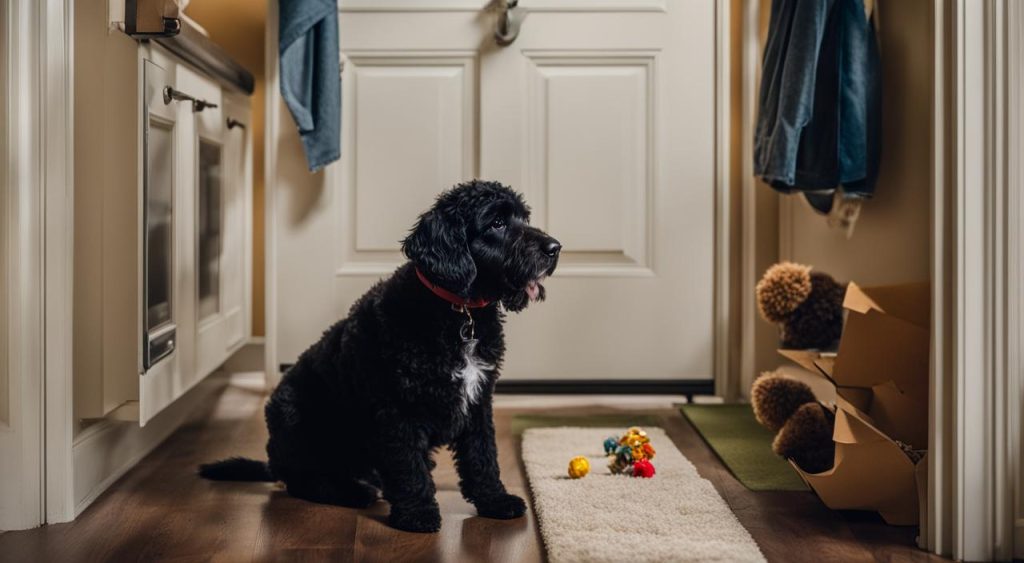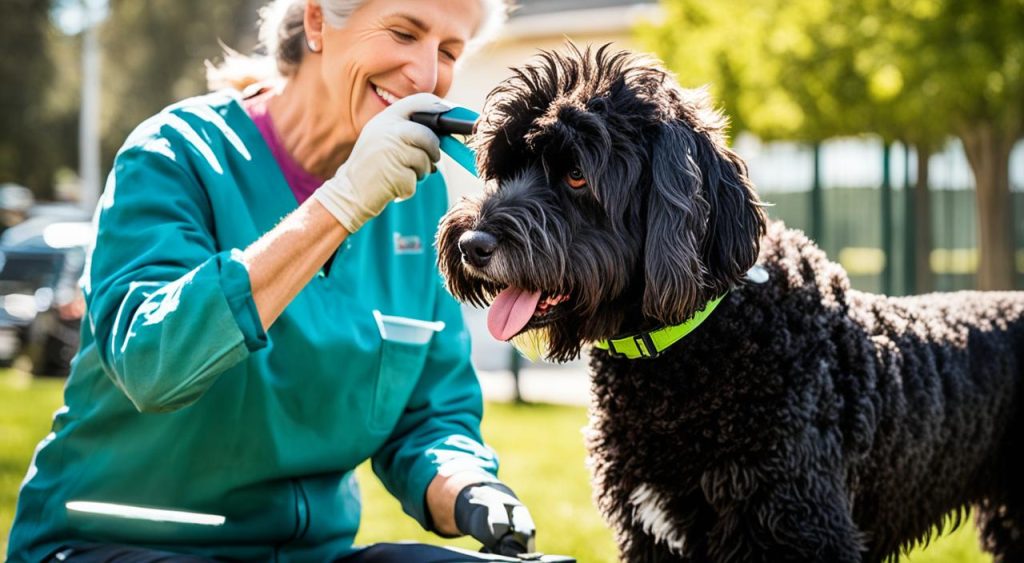Choosing a Portuguese Water Dog can be an exciting but challenging decision. One of the key considerations is whether to get a male or female dog. Both genders have their own unique traits and characteristics that may influence your choice. To help you make an informed decision, it’s important to explore the differences between male and female Portuguese Water Dogs and how they align with your preferences and lifestyle.
Key Takeaways:
- Consider the pros and cons of male and female Portuguese Water Dogs.
- Take into account the personality and temperament differences between the genders.
- Think about the size and appearance that suits your preferences and living arrangements.
- Evaluate the training and behavioral considerations for each gender.
- Be aware of the potential health and care needs of male and female Portuguese Water Dogs.
Personality and Temperament
When it comes to the personality and temperament of male and female Portuguese Water Dogs, there are distinct characteristics and behavior differences to consider. Understanding these traits will help you make an informed decision when choosing the right companion for your lifestyle.
Male Portuguese Water Dogs are known for their outgoing nature and eagerness to please their owners. They are often more loyal and affectionate, making them excellent candidates for pet therapy. However, their strong-willed nature can sometimes manifest as stubbornness, and they may test their owner’s authority from time to time.
On the other hand, female Portuguese Water Dogs tend to be more independent and unpredictable. They possess excellent multitasking skills and are known for their ability to assert their dominance using subtle actions. While they can be more assertive, they still display loyalty and affection towards their owners, albeit in their own unique way.
When deciding between a male or female Portuguese Water Dog, consider whether you prefer a companion that is more loyal and affectionate or one that is more independent and assertive. Both genders have their distinctive qualities that can bring joy and companionship to your life.
Size and Appearance
When considering whether to get a male or female Portuguese Water Dog, it’s important to take into account the differences in size and appearance between the two genders. Male Portuguese Water Dogs are generally slightly larger and heavier than females. They have deeper chests, larger heads, and more muscular builds.
The average height for a male Portuguese Water Dog is between 20 to 23 inches, while females typically stand at around 17 to 21 inches. In terms of weight, males typically range from 45 to 60 pounds, while females weigh between 35 to 50 pounds.
These differences in size and appearance should be a consideration when deciding which gender of Portuguese Water Dog is best suited to your preferences and living arrangements.
Training and Behavioral Considerations
Both male and female Portuguese Water Dogs are intelligent and trainable. However, there are slight differences in their behavior and trainability.
Male dogs tend to mature slowly and may exhibit puppy-like mannerisms for longer. They may also test their owner’s authority during adolescence, requiring consistent and firm training.
Females, on the other hand, mature faster and are generally easier to train. They respond well to positive reinforcement and are quick to learn new concepts.
When training male and female Portuguese Water Dogs, it’s essential to be patient, consistent, and use positive reinforcement techniques. Both genders are eager to please their owners and can excel in various training activities.
“Training a Portuguese Water Dog is a rewarding experience. Their intelligence and eagerness to learn make them highly trainable. However, it’s important to understand the behavioral differences between males and females and adjust your training methods accordingly.”
Male dogs may require more time and effort to establish their boundaries and understand their place in the family hierarchy. It’s crucial to establish yourself as the pack leader and set clear expectations from the beginning.
Female dogs, on the other hand, are generally more responsive to training and thrive on positive reinforcement. They are quick learners and are eager to please, making training sessions enjoyable and productive.
Regardless of gender, consistency, positive reinforcement, and early socialization are key to successfully training Portuguese Water Dogs. Consider your training preferences and ability to manage potential stubbornness when choosing between a male or female Portuguese Water Dog.
Health and Care
When considering the health of male and female Portuguese Water Dogs, it’s important to note that certain health issues are more breed-related than gender-specific. Both genders can be prone to common health concerns. Some of these include hip dysplasia, Addison’s disease, microphthalmia, and inflammatory bowel disease.
To ensure the health of your Portuguese Water Dog, it is crucial to partner with a reputable breeder who conducts health screenings and maintains the well-being of their breeding dogs. Regular veterinary check-ups and proper care are essential in preventing and managing these health issues.
Furthermore, considering the potential health benefits of neutering or spaying your dog is crucial. Neutering or spaying can reduce the risk of certain cancers and infections in both male and female Portuguese Water Dogs.
Neutering and Spaying Considerations
Neutering or spaying your Portuguese Water Dog is an important decision that can have long-term effects on their health and behavior. Research suggests that elective surgeries should not be performed before the dog’s growth plates have closed, which is typically between 18 to 24 months of age. Early removal of hormones can lead to growth abnormalities and weak tendons. It is also important to consider the timing of surgeries in relation to the dog’s heat cycle. Females may experience 2-3 heats before spaying is recommended. Consult with your veterinarian to determine the best timing for neutering or spaying your Portuguese Water Dog.
Compatibility with Current Pets
If you already have a dog in your household, it is important to consider their gender when introducing a new Portuguese Water Dog. Choosing the right gender combination can help minimize potential dominance or aggression issues between your pets. As a general rule, it is recommended to choose the opposite gender of your current dog. For example, if you have a male dog, consider getting a female Portuguese Water Dog as a companion.
When introducing a new Portuguese Water Dog to your existing pet, it is essential to ensure proper introductions and supervision. The process should be gradual, allowing the dogs to get acquainted and establish a positive relationship. It is recommended to introduce the new dog when your current dog is at least 2 years old. At this age, they are more likely to have developed a stable temperament and are less likely to engage in dominance struggles.
Ensure that the initial meetings between your dogs are supervised and take place in a neutral area. This can help prevent territorial disputes and reduce the chances of conflict. Be patient and allow the dogs to interact at their own pace, offering positive reinforcement and rewards for calm and appropriate behavior.
“Introducing a new Portuguese Water Dog to your existing pet should be done gradually and with proper supervision.”
Remember that each dog has its own unique personality, and compatibility between male and female Portuguese Water Dogs may vary. It is important to assess the individual temperaments and behaviors of your dogs to ensure a harmonious and peaceful coexistence. Seeking guidance from a professional dog trainer or behaviorist can also be helpful in managing the introduction process.
With time, patience, and consistent training, male and female Portuguese Water Dogs can develop strong bonds and become excellent companions for each other, providing years of love and joy to your household.
Shedding and Allergies
Portuguese Water Dogs are known for their hypoallergenic qualities, which make them a popular choice for individuals with allergies. These dogs have a single coat and shed less compared to double-coated breeds. However, it’s important to note that they do shed to some extent, and their hair can mat if not properly groomed. While no dog is completely non-allergenic, Portuguese Water Dogs produce fewer allergens compared to other breeds.
If you have severe allergies, it’s recommended to spend time with a Portuguese Water Dog before bringing one into your home to gauge your sensitivity to their dander. Regular grooming and maintenance, including brushing their coat and keeping it clean, can help manage shedding and minimize allergens in your living environment.
Interaction with Children
Portuguese Water Dogs can be great family dogs, but the age of the children is an important consideration. PWDs can play rough and be exuberant jumpers, which can potentially knock over small children. Additionally, they may engage in mouthing and biting behaviors during play. Proper training, supervision, and teaching children how to interact with dogs are essential. It is generally recommended that families with young children consider other breeds or wait until their children are older before bringing a Portuguese Water Dog into their home.
Intelligence and Trainability
Portuguese Water Dogs are highly intelligent and trainable. Both male and female Portuguese Water Dogs possess remarkable cognitive abilities, making them quick and receptive learners. However, there are subtle differences in how they process information and respond to training.
Female Portuguese Water Dogs tend to mature faster and exhibit a keen ability to learn and adapt their skills. They are visually oriented and excel at detecting even the most minute changes in their environment. This heightened visual awareness allows them to grasp commands and cues with precision.
On the other hand, male Portuguese Water Dogs are more scent-oriented, relying heavily on their olfactory senses. They may not notice or be as easily distracted by visual changes in their surroundings. This scent-focused inclination can be advantageous in certain situations that require tracking or search-and-rescue activities.
Regardless of gender, Portuguese Water Dogs respond well to positive reinforcement techniques. Using rewards and praise to reinforce desired behaviors, such as treats, toys, or verbal affirmations, can motivate them to consistently perform tasks and obey commands.
Remember to approach training sessions with patience, consistency, and a calm, assertive demeanor. Building a strong bond and trust with your Portuguese Water Dog will promote successful training outcomes and foster a harmonious relationship.
Now, let’s explore other factors to consider when choosing between a male or female Portuguese Water Dog.
Exercise and Energy Levels
Portuguese Water Dogs are known for their active and energetic nature. Regular exercise is essential to keep them physically and mentally stimulated. While energy levels may vary between individual dogs, male Portuguese Water Dogs typically exhibit higher levels of activity, especially during their younger years. However, as they mature, these energy levels tend to even out.
Regardless of their gender, it is important to provide Portuguese Water Dogs with adequate exercise to prevent boredom and destructive behavior. Engage them in activities that challenge their physical abilities and mental acuity. This can include daily walks, swimming sessions, interactive play, and obedience training.
Regular exercise not only helps maintain their overall fitness, but it also strengthens the bond between you and your furry companion. Consider the age, health condition, and specific needs of your Portuguese Water Dog when designing their exercise routine.
Breeding Considerations
When it comes to breeding male and female Portuguese Water Dogs, responsible practices and guidance from a reputable breeder are essential. Female Portuguese Water Dogs typically reach sexual maturity at around six months of age, marking the beginning of their heat cycles. However, it is generally recommended to wait until the second or third heat cycle before considering breeding. This waiting period allows the female dog to become physically mature and reduces the risk of potential pregnancy complications.
For male Portuguese Water Dogs, they can start mating once they reach sexual maturity. However, it is advisable to wait until they are at least two years old before breeding. This additional time allows the male dog to fully develop physically and psychologically, improving the chances of successful breeding.
Breeding Portuguese Water Dogs should only be undertaken with the intention of improving the breed and should be approached with careful consideration and a deep understanding of the breed’s characteristics. It is not a decision to be taken lightly, as responsible breeding practices contribute to the overall health and well-being of the Portuguese Water Dog population.
Cost Considerations
Portuguese Water Dogs are often considered a more expensive breed. The price for a young Portuguese Water Dog puppy typically ranges from $2500 to $3000. Older puppies and adult dogs are usually less expensive.
The cost of a Portuguese Water Dog can vary based on factors such as the breeder’s reputation, the pedigree of the dog, and the specific qualities of the individual dog. Breeders who have established a strong reputation for breeding high-quality Portuguese Water Dogs may charge a higher price for their puppies.
However, it is important to be wary of unusually low prices, as this may indicate potential health or breeding issues. A higher price does not necessarily guarantee a responsible breeder, so thorough research and evaluation are crucial when considering the cost of a Portuguese Water Dog. Take the time to visit the breeder, ask questions about their breeding practices, and request to see the puppy’s parents to assess their health and temperament.
Additionally, consider the additional costs that come with owning a Portuguese Water Dog, such as veterinary care, grooming, training, and supplies. These expenses should also be factored into your budget when considering the overall cost of owning a Portuguese Water Dog.
Responsible Breeding Practices
Responsible breeders play a crucial role in ensuring the health and well-being of Portuguese Water Dogs. They adhere to specific practices that prioritize the welfare of these beloved pets. By following responsible breeding practices, breeders help maintain the integrity of the breed and produce healthy, well-socialized puppies.
One of the key practices of responsible breeders is their involvement in conformation dog shows. These events serve as a platform for assessing the quality of their dogs and ensuring they meet the breed standards. By participating in conformation shows, breeders can showcase the excellence of their Portuguese Water Dogs.
Furthermore, responsible breeders prioritize the health of their breeding dogs. They conduct recommended health tests to identify and address any potential genetic or hereditary conditions. Only dogs with favorable health results are carefully selected for breeding. This dedication to health testing helps reduce the risk of passing on genetic diseases to future generations.
Responsible breeders also understand the importance of providing a nurturing environment for their puppies. They raise their litters in a social setting, exposing them to various stimuli and experiences. This early socialization contributes to the puppies’ well-rounded temperaments and better prepares them for life in their forever homes.
Extensive veterinary care is another hallmark of responsible breeders. They ensure that their dogs receive regular veterinary check-ups, vaccinations, and appropriate medical treatments. This commitment to healthcare helps promote the overall well-being and longevity of the dogs in their breeding program.
When it comes to finding suitable homes for their puppies, responsible breeders carefully screen potential owners. They want to ensure that each dog is placed in an environment that aligns with its needs and characteristics. This screening process helps foster successful matches between the dog and the family, setting them up for a lifetime of happiness together.
In addition, responsible breeders provide comprehensive support to new owners. They offer written contracts that outline the responsibilities of both the breeder and the new owner. These contracts often include provisions for health guarantees, spay/neuter requirements, and the breeder’s willingness to take back the dog if necessary. By offering guidance and support, reputable breeders empower new owners to provide the best care for their Portuguese Water Dogs.
When searching for a Portuguese Water Dog, it is paramount to seek out a reputable breeder who follows these responsible breeding practices. By doing so, you can have confidence in the quality and integrity of the puppy you bring into your home. Responsible breeders are committed to preserving and improving the breed while prioritizing the health and well-being of their dogs.
Conclusion
Choosing between a male or female Portuguese Water Dog requires careful consideration of various factors. Both genders possess distinct characteristics, and the decision should be based on your preferences, lifestyle, and household dynamics.
Consider factors such as temperament, size, training needs, health considerations, compatibility with current pets, shedding, interaction with children, intelligence, exercise requirements, breeding considerations, and cost. Consulting with reputable breeders and experienced owners can provide valuable insights and guidance in making an informed decision.
In the end, choose the gender that best aligns with your specific needs and desires. Whether you opt for a male or female Portuguese Water Dog, their unwavering companionship and joy will enhance your life for years to come.



